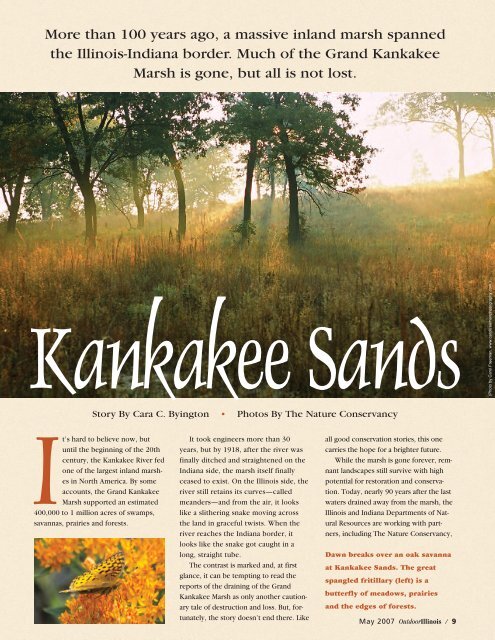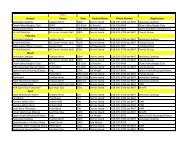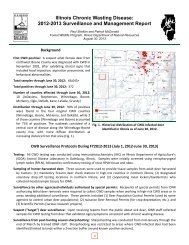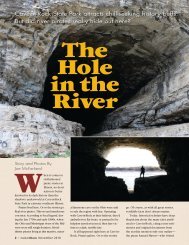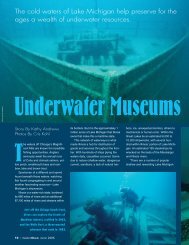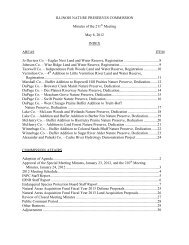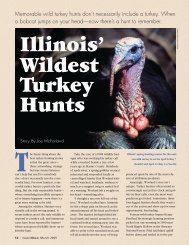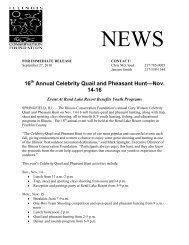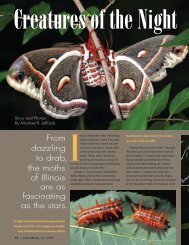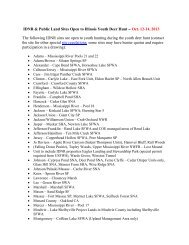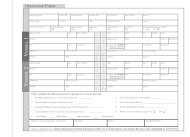OutdoorIllinois May 2007 Kankakee Sands - Illinois DNR
OutdoorIllinois May 2007 Kankakee Sands - Illinois DNR
OutdoorIllinois May 2007 Kankakee Sands - Illinois DNR
You also want an ePaper? Increase the reach of your titles
YUMPU automatically turns print PDFs into web optimized ePapers that Google loves.
More than 100 years ago, a massive inland marsh spanned<br />
the <strong>Illinois</strong>-Indiana border. Much of the Grand <strong>Kankakee</strong><br />
Marsh is gone, but all is not lost.<br />
<strong>Kankakee</strong> <strong>Sands</strong><br />
I<br />
Story By Cara C. Byington • Photos By The Nature Conservancy<br />
t’s hard to believe now, but<br />
until the beginning of the 20th<br />
century, the <strong>Kankakee</strong> River fed<br />
one of the largest inland marshes<br />
in North America. By some<br />
accounts, the Grand <strong>Kankakee</strong><br />
Marsh supported an estimated<br />
400,000 to 1 million acres of swamps,<br />
savannas, prairies and forests.<br />
It took engineers more than 30<br />
years, but by 1918, after the river was<br />
finally ditched and straightened on the<br />
Indiana side, the marsh itself finally<br />
ceased to exist. On the <strong>Illinois</strong> side, the<br />
river still retains its curves—called<br />
meanders—and from the air, it looks<br />
like a slithering snake moving across<br />
the land in graceful twists. When the<br />
river reaches the Indiana border, it<br />
looks like the snake got caught in a<br />
long, straight tube.<br />
The contrast is marked and, at first<br />
glance, it can be tempting to read the<br />
reports of the draining of the Grand<br />
<strong>Kankakee</strong> Marsh as only another cautionary<br />
tale of destruction and loss. But, fortunately,<br />
the story doesn’t end there. Like<br />
all good conservation stories, this one<br />
carries the hope for a brighter future.<br />
While the marsh is gone forever, remnant<br />
landscapes still survive with high<br />
potential for restoration and conservation.<br />
Today, nearly 90 years after the last<br />
waters drained away from the marsh, the<br />
<strong>Illinois</strong> and Indiana Departments of Natural<br />
Resources are working with partners,<br />
including The Nature Conservancy,<br />
Dawn breaks over an oak savanna<br />
at <strong>Kankakee</strong> <strong>Sands</strong>. The great<br />
spangled fritillary (left) is a<br />
butterfly of meadows, prairies<br />
and the edges of forests.<br />
<strong>May</strong> <strong>2007</strong> <strong>Outdoor<strong>Illinois</strong></strong> / 9<br />
(Photo by Carol Freeman, www.carolfreemanphotography.com.)
Some of the Midwest’s finest<br />
examples of prairie and sand<br />
savanna habitats are found an<br />
hour southeast of Chicago.<br />
the <strong>Illinois</strong> Nature Preserves Commission<br />
and Friends of the <strong>Kankakee</strong>, to preserve<br />
the surviving prairies and savannas of<br />
<strong>Kankakee</strong> <strong>Sands</strong>. The lands here, particularly<br />
the sand prairies in Indiana and the<br />
prairies and oak savannas in <strong>Illinois</strong>,<br />
remain some of the most outstanding<br />
opportunities for landscape conservation<br />
in the Midwest.<br />
In this place, an hour southeast of<br />
Chicago on the border between <strong>Illinois</strong><br />
and Indiana, a presettlement landscape<br />
known to the Potawatomis still exists<br />
among the most modern farming practices<br />
in the world. Portions of the Pembroke<br />
Savannas and the <strong>Kankakee</strong> River<br />
were recognized by the <strong>Illinois</strong> Natural<br />
Areas Inventory in 1978 as natural areas<br />
of statewide significance. The Nature<br />
Conservancy considers the Pembroke<br />
Savannas one of the most important conservation<br />
areas in the state and the U. S.<br />
Fish and Wildlife Service considers the<br />
Pembroke Savannas to be the largest concentration<br />
of high-quality sand savannas<br />
surviving in the Midwest.<br />
“Some of the largest and finest sand<br />
savannas in <strong>Illinois</strong> are in the Pembroke<br />
area,” said Don McFall, Natural Areas<br />
Acquisition program manager with the<br />
<strong>DNR</strong> Office of Realty and Environmental<br />
Planning. “The variety of wildlife they<br />
support, including endangered species,<br />
is remarkable. <strong>DNR</strong> is using the Natural<br />
Areas Acquisition Fund to buy some<br />
of these savannas to set aside as state<br />
natural areas.”<br />
Scientists, photographers and<br />
wildlife watchers appreciate the<br />
area’s unusual, sandy-soiled habitats<br />
and range of flora and fauna.<br />
To help preserve the Pembroke<br />
Savannas and other important natural<br />
areas at <strong>Kankakee</strong> <strong>Sands</strong>, <strong>DNR</strong>, The<br />
Nature Conservancy and their partners<br />
in both <strong>Illinois</strong> and Indiana, currently<br />
own more than 23,000 acres of protected<br />
areas within the <strong>Kankakee</strong> <strong>Sands</strong><br />
region. Together, the partners are working<br />
to enlarge, connect and restore these<br />
protected areas to help ensure the longterm<br />
survival of an outstanding variety of<br />
plants and animals.<br />
Because of its unusual sandy soils, the<br />
<strong>Kankakee</strong> <strong>Sands</strong> area supports a range of<br />
species that are not usually seen in other<br />
parts of the state, including ornate box<br />
turtles and the plains pocket gopher,<br />
which are more commonly found west of<br />
the Mississippi River. In fact, ornate box<br />
turtles were once thought to be quite<br />
common here, but a recent survey on<br />
<strong>DNR</strong> and Conservancy land revealed that<br />
ornate box turtles were not as common<br />
as scientists had thought.<br />
In fact, these small turtles with their<br />
distinctive yellow markings are apparently<br />
no longer common at all. After three<br />
years of looking, scientists from the <strong>Illinois</strong><br />
Natural History Survey found exactly<br />
two turtles.<br />
“Something is limiting ornate box turtles<br />
at <strong>Kankakee</strong> <strong>Sands</strong>,” noted Chris<br />
Phillips, a herpetologist with the survey.<br />
“But at this point we don’t know what<br />
and that could be worrisome for other<br />
savanna species here.”<br />
10 / <strong>Outdoor<strong>Illinois</strong></strong> <strong>May</strong> <strong>2007</strong>
Scientists speculate that the population<br />
may have suffered from any number<br />
of problems, including over-collection by<br />
people seeking to use or sell ornate box<br />
turtles as pets. Like the ornate box turtles,<br />
the savanna’s other special residents<br />
could be at risk without ongoing preservation<br />
efforts.<br />
The plains pocket gopher is seldom<br />
seen, but their mounds are impossible to<br />
miss, especially after a fire burns<br />
through a savanna. Pocket gophers are<br />
constantly moving vegetation and soil<br />
nutrients with their burrowing and digging.<br />
Because of their important role in<br />
the cycling of organic matter and nutrients,<br />
and their creation of small-scale but<br />
widely distributed surface disturbances<br />
in these sandy soils, the plains pocket<br />
gopher is considered a keystone species<br />
in the <strong>Kankakee</strong> <strong>Sands</strong> Ecosystem.<br />
Red-headed woodpeckers are another<br />
savanna species that once existed in<br />
large numbers across a wide range.<br />
Unfortunately, largely due to habitat<br />
loss, the population of these birds has<br />
declined by 80 percent in the Midwest<br />
over the last 40 years. But the prospects<br />
for red-headed woodpeckers at <strong>Kankakee</strong><br />
<strong>Sands</strong> are happier than those of the<br />
ornate box turtles.<br />
The <strong>Kankakee</strong> <strong>Sands</strong> macrosite<br />
contains more than 23,000<br />
protected acres spanning the<br />
<strong>Illinois</strong>-Indiana border.<br />
Rough Blazing Star<br />
The diversity of habitats within<br />
the macrosite provides the<br />
opportunity to easily view a<br />
variety of plants and animals.<br />
Today, scientists estimate that about<br />
300 breeding pairs of red-headed woodpeckers<br />
live in the savannas of <strong>Kankakee</strong><br />
<strong>Sands</strong>. In high-quality savannas such as<br />
the <strong>DNR</strong>’s Hooper Branch Savanna and<br />
the Conservancy’s Mskoda Land and<br />
Water Reserve and Pembroke Savanna<br />
Nature Preserve, red-headed woodpeckers<br />
are conspicuously numerous during<br />
breeding season and experience reproductive<br />
success at a rate that suggests<br />
good prospects for long-term survival of<br />
the species. A key factor for their breeding<br />
success in the savannas is the large<br />
number of black oak trees that have been<br />
(Photo by Carol Freeman, www.carolfreemanphotography.com.)<br />
Red-headed Woodpecker<br />
damaged by fires making them a smorgasbord<br />
for insect larvae and perfect for<br />
cavity-nesting birds such as the woodpeckers<br />
to peck out their nesting cavities.<br />
The quality of the winter habitat also is<br />
key to the survival of the red-headed<br />
woodpecker and the black oak savannas<br />
and pin oak flatwoods provide a profusion<br />
of acorns to sustain them through the<br />
winter and spring months.<br />
Cara C. Byington is a senior conservation<br />
writer with The Nature Conservancy.<br />
<strong>Kankakee</strong> <strong>Sands</strong> Macrosite<br />
Cross-border<br />
conservation<br />
The story of <strong>Kankakee</strong> <strong>Sands</strong> is one<br />
of enduring hope and outstanding<br />
opportunity. The Grand <strong>Kankakee</strong> Marsh<br />
is gone but not all is lost. <strong>DNR</strong> and its<br />
partners work in a project area that<br />
encompasses a landscape in <strong>Illinois</strong> and<br />
Indiana. Nature knows no political<br />
boundaries and the scale of the project<br />
is important because the relatively large<br />
size enables species to survive over the<br />
long term. By working together to<br />
enlarge and connect the surviving<br />
prairies and savannas in the <strong>Kankakee</strong><br />
<strong>Sands</strong>, it will offer us a lasting connection<br />
with the landscapes of our past.<br />
<strong>May</strong> <strong>2007</strong> <strong>Outdoor<strong>Illinois</strong></strong> / 11


